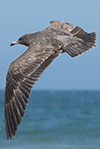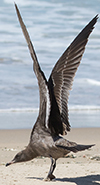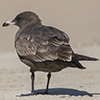|
||
Coordinators: 1cy June 2cy Jan 3cy Jan adult Jan |
1st cycle (1CY): September
OCTAVIO ABURTO USING SCIENCE TO INFLUENCE CONSERVATION
|
 Heermann's Gull heermannii 1st cycle (1CY), September 14 2018, San Luis Obispo, California USA. Picture: Alex Abela. Heermann's Gull heermannii 1st cycle (1CY), September 14 2018, San Luis Obispo, California USA. Picture: Alex Abela. |
 Heermann's Gull heermannii 1st cycle (1CY), September 14 2018, San Luis Obispo, California USA. Picture: Alex Abela. Heermann's Gull heermannii 1st cycle (1CY), September 14 2018, San Luis Obispo, California USA. Picture: Alex Abela. |
||
 Heermann's Gull heermannii 1st cycle (1CY), September 17 2017, Pismo Beach, California USA. Picture: Alex Abela. Heermann's Gull heermannii 1st cycle (1CY), September 17 2017, Pismo Beach, California USA. Picture: Alex Abela. |
||
 Heermann's Gull heermannii 1st cycle (1CY), September 14 2018, San Luis Obispo, California USA. Picture: Alex Abela. Heermann's Gull heermannii 1st cycle (1CY), September 14 2018, San Luis Obispo, California USA. Picture: Alex Abela. |
||
 Heermann's Gull heermannii 1st cycle (1CY), September 14 2018, San Luis Obispo, California USA. Picture: Alex Abela. Heermann's Gull heermannii 1st cycle (1CY), September 14 2018, San Luis Obispo, California USA. Picture: Alex Abela. |
||
 Heermann's Gull heermannii 1st cycle (1CY), September 14 2018, San Luis Obispo, California USA. Picture: Alex Abela. Heermann's Gull heermannii 1st cycle (1CY), September 14 2018, San Luis Obispo, California USA. Picture: Alex Abela. |
||
 Heermann's Gull heermannii 1st cycle (1CY), September 29 2018, San Luis Obispo, California USA. Picture: Alex Abela. Heermann's Gull heermannii 1st cycle (1CY), September 29 2018, San Luis Obispo, California USA. Picture: Alex Abela. |
||
 Heermann's Gull heermannii 1st cycle (1CY), September 17 2018, Pismo Beach, California USA. Picture: Alex Abela. Heermann's Gull heermannii 1st cycle (1CY), September 17 2018, Pismo Beach, California USA. Picture: Alex Abela. |
||
 Heermann's Gull heermannii 1st cycle (1CY), September 14 2018, San Luis Obispo, California USA. Picture: Alex Abela. Heermann's Gull heermannii 1st cycle (1CY), September 14 2018, San Luis Obispo, California USA. Picture: Alex Abela. |
||
 Heermann's Gull heermannii 1st cycle (1CY), September 14 2018, San Luis Obispo, California USA. Picture: Alex Abela. Heermann's Gull heermannii 1st cycle (1CY), September 14 2018, San Luis Obispo, California USA. Picture: Alex Abela. |
||
 Heermann's Gull heermannii 1st cycle (1CY), September 14 2018, San Luis Obispo, California USA. Picture: Alex Abela. Heermann's Gull heermannii 1st cycle (1CY), September 14 2018, San Luis Obispo, California USA. Picture: Alex Abela. |
||
 Heermann's Gull heermannii 1st cycle (1CY), September 14 2018, San Luis Obispo, California USA. Picture: Alex Abela. Heermann's Gull heermannii 1st cycle (1CY), September 14 2018, San Luis Obispo, California USA. Picture: Alex Abela. |
||
 Heermann's Gull heermannii 1st cycle (1CY), September 14 2018, San Luis Obispo, California USA. Picture: Alex Abela. Heermann's Gull heermannii 1st cycle (1CY), September 14 2018, San Luis Obispo, California USA. Picture: Alex Abela. |
||
 Heermann's Gull heermannii 1st cycle (1CY), September 14 2018, San Luis Obispo, California USA. Picture: Alex Abela. Heermann's Gull heermannii 1st cycle (1CY), September 14 2018, San Luis Obispo, California USA. Picture: Alex Abela. |
||
 Heermann's Gull heermannii 1st cycle (1CY), September 14 2018, San Luis Obispo, California USA. Picture: Alex Abela. Heermann's Gull heermannii 1st cycle (1CY), September 14 2018, San Luis Obispo, California USA. Picture: Alex Abela. |
||
 Heermann's Gull heermannii 1st cycle (1CY), September 14 2018, San Luis Obispo, California USA. Picture: Alex Abela. Heermann's Gull heermannii 1st cycle (1CY), September 14 2018, San Luis Obispo, California USA. Picture: Alex Abela. |
||
 Heermann's Gull heermannii 1st cycle (1CY), September 27 2012, Monterey, California USA. Picture: John Cant. Heermann's Gull heermannii 1st cycle (1CY), September 27 2012, Monterey, California USA. Picture: John Cant. |
||
 Heermann's Gull heermannii 1st cycle (1CY), September 27 2012, Monterey, California USA. Picture: John Cant. Heermann's Gull heermannii 1st cycle (1CY), September 27 2012, Monterey, California USA. Picture: John Cant. |
||
 Heermann's Gull heermannii 1st cycle (1CY), September 17 2017, Pismo Beach, California USA. Picture: Alex Abela. Heermann's Gull heermannii 1st cycle (1CY), September 17 2017, Pismo Beach, California USA. Picture: Alex Abela. |
||
 Heermann's Gull heermannii 1st cycle (1CY), September 17 2017, Pismo Beach, California USA. Picture: Alex Abela. Heermann's Gull heermannii 1st cycle (1CY), September 17 2017, Pismo Beach, California USA. Picture: Alex Abela. |
||
 Heermann's Gull heermannii 1st cycle (1CY), September 17 2017, Pismo Beach, California USA. Picture: Alex Abela. Heermann's Gull heermannii 1st cycle (1CY), September 17 2017, Pismo Beach, California USA. Picture: Alex Abela. |
||
 Heermann's Gull heermannii 1st cycle (1CY), September 17 2017, Pismo Beach, California USA. Picture: Alex Abela. Heermann's Gull heermannii 1st cycle (1CY), September 17 2017, Pismo Beach, California USA. Picture: Alex Abela. |
||
 Heermann's Gull heermannii 1st cycle (1CY), September 17 2017, Pismo Beach, California USA. Picture: Alex Abela. Heermann's Gull heermannii 1st cycle (1CY), September 17 2017, Pismo Beach, California USA. Picture: Alex Abela. |
||
 Heermann's Gull heermannii 1st cycle (1CY), September 17 2017, Pismo Beach, California USA. Picture: Alex Abela. Heermann's Gull heermannii 1st cycle (1CY), September 17 2017, Pismo Beach, California USA. Picture: Alex Abela. |
||
 Heermann's Gull heermannii 1st cycle (1CY), September 17 2017, Pismo Beach, California USA. Picture: Alex Abela. Heermann's Gull heermannii 1st cycle (1CY), September 17 2017, Pismo Beach, California USA. Picture: Alex Abela. |
||
 Heermann's Gull heermannii 1st cycle (1CY), September 06 2017, Pismo Beach, California USA. Picture: Alex Abela. Heermann's Gull heermannii 1st cycle (1CY), September 06 2017, Pismo Beach, California USA. Picture: Alex Abela. |
||
 Heermann's Gull heermannii 1st cycle (1CY), September 06 2017, Pismo Beach, California USA. Picture: Alex Abela. Heermann's Gull heermannii 1st cycle (1CY), September 06 2017, Pismo Beach, California USA. Picture: Alex Abela. |
||
 Heermann's Gull heermannii 1st cycle (1CY), September 06 2017, Pismo Beach, California USA. Picture: Alex Abela. Heermann's Gull heermannii 1st cycle (1CY), September 06 2017, Pismo Beach, California USA. Picture: Alex Abela. |
||
 Heermann's Gull heermannii 1st cycle (1CY), September 06 2017, Pismo Beach, California USA. Picture: Alex Abela. Heermann's Gull heermannii 1st cycle (1CY), September 06 2017, Pismo Beach, California USA. Picture: Alex Abela. |
||
 Heermann's Gull heermannii 1st cycle (1CY), September 06 2017, Pismo Beach, California USA. Picture: Alex Abela. Heermann's Gull heermannii 1st cycle (1CY), September 06 2017, Pismo Beach, California USA. Picture: Alex Abela. |
||
 Heermann's Gull heermannii 1st cycle (1CY), September 06 2017, Pismo Beach, California USA. Picture: Alex Abela. Heermann's Gull heermannii 1st cycle (1CY), September 06 2017, Pismo Beach, California USA. Picture: Alex Abela. |
||
 Heermann's Gull heermannii 1st cycle (1CY), September 19 2017, Pismo Beach, California USA. Picture: Alex Abela. Heermann's Gull heermannii 1st cycle (1CY), September 19 2017, Pismo Beach, California USA. Picture: Alex Abela. |
||
 Heermann's Gull heermannii 1st cycle (1CY), September 03 2017, Pismo Beach, California USA. Picture: Alex Abela. Heermann's Gull heermannii 1st cycle (1CY), September 03 2017, Pismo Beach, California USA. Picture: Alex Abela. |
||
 Heermann's Gull heermannii
Heermann's Gull heermannii

 Isla Rasa: Sea birds and Sardines
Isla Rasa: Sea birds and Sardines
 The Resource
The Resource The Future
The Future